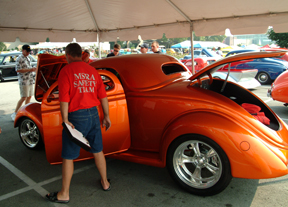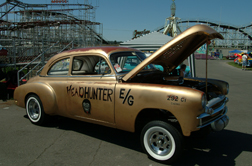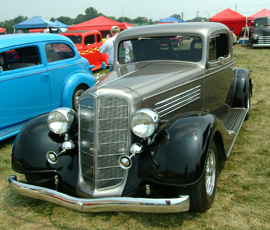Enter The NSRA
Now owners
wanted hot rods they could drive on the street, comfortably, safely
and efficiently. The National Street Rod Association (NSRA) was
formed in 1970, serving for the new street rods much the same
function as the NHRA did to organize, promote and establish
safety standards for drag racing early hot rods.
NSRA Street Rod Standards
Standards
NSRA organized a nationwide community of street rod enthusiasts
and established standards, a 17-point safety check, such as the
inspection given this picture-perfect bronze street rod
at the 2007 Louisville Nationals.
According to the NSRA:
“One of the fastest growing groups of enthusiasts interested in
the older cars are street rodders; the owners and builders of
street rods. A street rod is the most practical type of old
car.
“By definition a street rod is: An automobile of 1948 or earlier
manufacture which has undergone some type of modernization, to
include any of the following; engine, transmission, interior
refinements, and any other modifications the builder desires. A
street rod is to be driven to events under its own power and is to
be used as a safe, non-racing vehicle for total family
enjoyment.”
Street rods have the appeal of an old car, with the comfort and
safety of modern mechanics and conveniences. Street rods can be
built from original frames and bodies, or true replicas with
completely new frames or bodies, either steel or
fiberglass. For street rods, there are few
rules beyond the pre-1949 cutoff.
Presumably, the legislative codes of some states derived from the
NSRA standards. For example, the Pennsylvania Code reads:
Street rod—A motor
vehicle, or a reproduction thereof, with a model year of 1948 or
older which has been materially altered or modified by the removal,
addition or substitution of essential parts and with a gross weight
or registered gross weight of not more than 9,000
pounds.
At NSRA Nationals, no original or replica vehicle newer
than 1948 is allowed to enter. This eliminates the classic
cars and muscle cars.
All vehicles must drive onto the Exposition Center grounds under
their own power. Attend the Nationals and you will see every sort
of pre-1949 hot rod imaginable – traditional rods, rat rods, hot
rod trucks and buses, hot rod motorcycles, and thousands of
gorgeous street rods, including show cars so long as they are
operable.
See Muscle Cars & Classic Cars at
Other Hot Rod Shows
At many local hot rod shows, however, all antique cars (vehicles
more than 25 years old) are welcome. You can enjoy a variety of
muscle cars as well as some fine classic cars from the 1950s, such
as the 1959 Cadillac El Dorado, whose owners often set hearts
aflutter while driving them on the streets.
So what sets these sub-classes apart? We wouldn't want to limit
by definition, so work with us here ... imagine a flowing contiuum
rather than sharp delineation.
Sub-Classes of Hot
Rods

If a “hot rod” is a vehicle that has been custom-built or
modified to go faster, then technically, muscle cars and today’s
modern dragsters and race cars are all hot rods. Indeed, most
people who love big-block cars will have a favorite era, but
appreciate other high-performance cars.
Within the hot rod culture, these pre-1949 cars are
the accepted “hot rods” as the term is commonly used.
Even within that narrower range, some hot rod
owners compete their cars in drag races. NSRA
defines a street rod as a car that is driven, not raced. However,
even replica street rods are entered in drag racing competitions
sponsored by local clubs and shows! For example, the Good Guys
pacific Northwest Nationals sponsors a Friday night drag race at
Pacific Raceways in Kent, Washington.
On the other hand, many rat rods and traditional rods are only
driven, not raced, and therefore technically fall within the street
rod category. Yet many of their owners recoil at the idea of anyone
calling their true-to-period vehicle a Street Rod.
Why?
Traditional Rods and Rat
Rods

Building Traditional Rods is a growing trend to return to hot
rodding’s roots. A traditional hot rod is built by its owner, put
together using as many original parts as possible. Stay
period-correct with the style, theme and all parts of the vehicle.
For instance, older cars would have a generator, not an alternator.
There is a lot of gray area and cross over, but purists look at the
correctness of every bolt.
Traditional Rodders do not necessarily limit themselves to
the pre-1949 rule either.
Some rat rods might be considered an extreme faction of
traditional rods. Other rat rodders go all-out to make an
artistic statement of their own.
| 








 Standards
Standards
